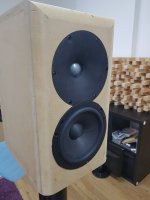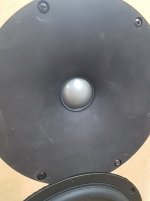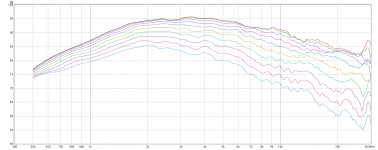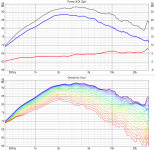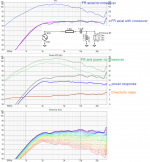Just to share very nice results of T34B plus 7" custom waveguide combination. Today I measured horizontal responses 0-90deg. I could not wish better results. Measurement was done in 2way cabinet with rounded edges to smooth out the responses as much as possible, mic distance 70cm, and gatting 4ms. My mic is calibrated to 25kHz.
This combo is planned for large 3way project with 18WE as midrange and 32W/4878T00 in sealed cabinet. Fully active, alldriven by OctoDAC with implemented miniSharc and 3 stereo power amps BV PA300SSE.
This combo is planned for large 3way project with 18WE as midrange and 32W/4878T00 in sealed cabinet. Fully active, alldriven by OctoDAC with implemented miniSharc and 3 stereo power amps BV PA300SSE.
Attachments
Yummy! Subscribed...
What are your thoughts on breaking the beryllium dome? I have never dared to open up a Be dome driver. They say Be is very brittle and likes to break easily...
What are your thoughts on breaking the beryllium dome? I have never dared to open up a Be dome driver. They say Be is very brittle and likes to break easily...
mbrennwa: I was very careful when removing the grill and during whole mounting to WG. I do not feel much comfortable to leave the dome exposed like that, so fabric grills will be made, to cover whole baffle. As WG is made out of alloy, I am thinking of making some protective elemets similar to Satori Be tweeters, or to use original T34B grills and attach them to waveguides.
I added also Vituix graphs, power response and DI.
As I already know the sound of T25B, and I like it very much, I cannot wait to listen to this combo.
I added also Vituix graphs, power response and DI.
As I already know the sound of T25B, and I like it very much, I cannot wait to listen to this combo.
Attachments
Last edited:
T34B + WG:
- at 2kHz 0-60deg SPL difference is -4dB
From my measurements of 18WU, there is -5.8dB difference. Datasheet value is -5dB.
From datasheet, 18WE has that difference -4dB. So in baffle I expect ~-5dB.
So for frequencies around 2kHz directivities of 18WE and T34B WG are well matched. I will try to make crossover frequency ~1500Hz, maybe even lower.
- at 2kHz 0-60deg SPL difference is -4dB
From my measurements of 18WU, there is -5.8dB difference. Datasheet value is -5dB.
From datasheet, 18WE has that difference -4dB. So in baffle I expect ~-5dB.
So for frequencies around 2kHz directivities of 18WE and T34B WG are well matched. I will try to make crossover frequency ~1500Hz, maybe even lower.
Last edited:
Looks damn nice. It'll be killer.
These BE domes are probably foil based rather than PVD. They should be quite a bit more durable. Tears or rips instead of shattering. Still wouldn't want to leave them exposed either way
These BE domes are probably foil based rather than PVD. They should be quite a bit more durable. Tears or rips instead of shattering. Still wouldn't want to leave them exposed either way
This is the project for client so I do not have the electronics in my hands yet. This OctoDAC-miniSharc unit might be one of early production or custom units as I do not see it listed on the website.
Nice graphs continue.......
Today I took SPL calibrated measurement and impedance measurement, and tried to model LR4 crossover at 1500Hz and 85dB. So far it looks promising and easy to work with.
As midrange driver runs into waveguide partially, and was not properly flush mounted, I expect irregularities around 10kH to smooth out a little when midrange is installed properly.
Today I took SPL calibrated measurement and impedance measurement, and tried to model LR4 crossover at 1500Hz and 85dB. So far it looks promising and easy to work with.
As midrange driver runs into waveguide partially, and was not properly flush mounted, I expect irregularities around 10kH to smooth out a little when midrange is installed properly.
Attachments
Last edited:
The curves look pretty, but as always with Vituix it is hard to tell which curve is what. A legend would help a lot, but Kimmo doesn't want legends...
I wouldn't worry about those minor wiggles at 10 kHz.
I wouldn't worry about those minor wiggles at 10 kHz.
It is somewhat rare for a tweeter circuit to require a coil of a magnitude much larger than about 0.6mH, so I was mainly stating that a 1.1mH coil is a rather large value to use in a tweeter circuit.
Being this, and the fact that you have a ~4 ohm resistor as your DCR value, the coil really is not doing all that much. If it were say 2.5 ohms or less, the additional coil might actually be contributing quite a bit more to the response than it truly is currently.
Thusly, my response to you was targeted that the coil and resistor might not really be a necessary component addition to the circuit to get the response profile you are trying to achieve, and not really worth the additional cost.
Hope that helps,
Wolf
Being this, and the fact that you have a ~4 ohm resistor as your DCR value, the coil really is not doing all that much. If it were say 2.5 ohms or less, the additional coil might actually be contributing quite a bit more to the response than it truly is currently.
Thusly, my response to you was targeted that the coil and resistor might not really be a necessary component addition to the circuit to get the response profile you are trying to achieve, and not really worth the additional cost.
Hope that helps,
Wolf
Last edited:
You are basically right, that high mH coil is rarely needed in typical dome tweeter crossovers, but from my experience, it is little bit different for waveguided domes, and especially with low crossover point and high sensitivity. I added graphs when coil is disconnected. Without the coil, FR is more LR2.
So far these are just preparational steps, it looks that desired slope and Fc can be realized with very simple filter.
So far these are just preparational steps, it looks that desired slope and Fc can be realized with very simple filter.
Attachments
... which in this case is a non-issue, since the project is planned fully active with DSP - perhaps the HP R and C will be kept and the FR finely shaped with the DSP.
Actually I am very tempted to tell carpenter to build two pairs if the cabinets and make one pair with passive crossover, for me.
And yes, there have to be some passive components in tweeter crossover even in full active version to ensure protection of the tweeter.
And yes, there have to be some passive components in tweeter crossover even in full active version to ensure protection of the tweeter.
Actually I am very tempted to tell carpenter to build two pairs
But you will resist the temptation, right? 🙂
- Home
- Loudspeakers
- Multi-Way
- New project: Bliesma T34B in WG, 18WE, 32W
